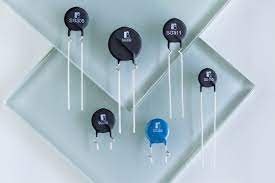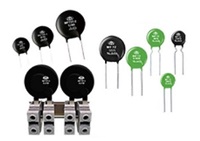THERMISTORS FREQUENTLY ASKED QUESTIONS
 Thermistors (Thermally Sensitive Resisstor), are solid state, electronic devices which detect thermal environmental changes for use in temperature measurement, control and compensation circuitry. Thermistors are inexpensive, easily-obtainable temperature sensors. Thermistors are widely used for simple temperature measurements. Temperature sensors comprised of two basic thermistor technologies:
Thermistors (Thermally Sensitive Resisstor), are solid state, electronic devices which detect thermal environmental changes for use in temperature measurement, control and compensation circuitry. Thermistors are inexpensive, easily-obtainable temperature sensors. Thermistors are widely used for simple temperature measurements. Temperature sensors comprised of two basic thermistor technologies:

Negative Temperature Coefficient (NTC) Thermistors
NTC (Negative Temperature CoeffiCient) is refers to with the increase of temperature resistance was thermistor phenomenon and the material index decreases, with negative temperature coefficient. The material is ceramic semiconductor using manganese, copper, cobalt, iron, silicon, nickel, zinc and other two kinds or more than two kinds of metal oxides for mixing, molding, sintering and become, can be made with a negative temperature coefficient (NTC) thermistor. The resistivity and material constants with the material composition, sintering atmosphere, sintering temperature and structure changes.
Positive Temperature Coefficient (PTC) Thermistors
PTC is Positive Temperature Coefficient acronym, meaning is positive temperature coefficient, temperature coefficient of the great semiconductor materials or components. Usually we mentioned PTC. Temperature coefficient thermistor, referred to as PTC thermistor.
The PTC thermistor is semiconductor resistance with temperature sensitivity of a typical, above a certain temperature (Curie temperature), its resistance value with the increase of temperature in step increase.
Thermistors Questions
What is an NTC thermistor?
The word ‘thermistor’ is derived from the phrase THERMally-sensitive resISTOR and “NTC” stands for Negative Temperature Coefficient. This means that NTC thermistors have an inverse relationship between their electrical resistance and body temperature.
If NTC thermistors have a non-linear temperature characteristic, are they difficult to use?
No, although this resistance/temperature (R/T) characteristic is non-linear, it is predictable, repeatable, and can be reproduced to exacting specifications. As a result of Ametherm’s superior thermistor technology and improvements in electronic instrumentation, the non-linearity of the NTC thermistor characteristic no longer poses a difficulty for design engineers.
From what materials are NTC thermistors made?
NTC thermistors are small, rugged ceramic semiconductors manufactured from compositions of the oxides of metals, such as manganese, nickel, cobalt, copper, and/or iron. Each NTC thermistor composition or mix, has a specific ratio of metal oxides which defines the thermistor’s physical dimensions, R/T curve and its resistance at 25°C.
Since the resistance changes with temperature, how are NTC thermistors specified?
The resistance value of a thermistor is typically referenced at 25°C (abbreviated to “R25”). The most common R25 values used for thermistor applications are between 100 ohms and 100 k ohms. Other R25 values as low as 50 ohms and as high as 1 megohms can be produced and resistance values at temperature points other that 25°C can be specified.
Are NTC thermistors sensitive to temperature changes?
NTC thermistors also exhibit a relatively large change in resistance vs. temperature, typically on the order of -3 % to -6 % per °C, providing a much greater sensitivity or signal response to changes in temperature when compared to other temperature sensors, such as thermocouples and RTDs.
What is the best tool for describing the NTC thermistor R/T characteristic?
Overall, the Steinhart-Hart equation is the most useful tool for interpolating the NTC thermistor R/T curve characteristic. The Steinhart-Hart equation is a third order polynomial which provides excellent curve fitting for specific temperature spans within the temperature range of -80°C to 260°C.
How does aging affect thermistor stability?
“Thermometric drift” is a specific type of drift in which the drift is the same amount of temperature at all temperatures of exposure. For example, a thermistor that exhibits a -0.02°C shift at 0°C, 40°C and 70°C (even though this is a different percentage change in resistance in each case) would be exhibiting thermometric drift. Thermometric drift: (1) occurs over time at varying rates, based on thermistor type and exposure temperature, and (2) as a general rule, increases as the exposure temperature increases. Most drift is thermometric.
What happens if my application exceeds the temperature rating?
Intermittent temperature incursions above and below the operating range will not affect long-term survivability. Encapsulate epoxy typically begins to break down at 150°C and the solder attaching leads to the thermistor body typically reflows at about 180°C. Either condition could result in failure of the thermistor.
Are thermistors ESD sensitive?
Thermistors by definition are not ESD sensitive.
What is the resolution of a thermistor?
There is no limit to the resolution of a thermistor. The limitations are in the electronics needed to measure to a specified resolution. Limitations also exist in determining the accuracy of the measurement at a specified resolution.
Are Ametherm thermistors RoHS compliant?
(What if I don’t want a lead free part?) Ametherm maintains two separate manufacturing lines to meet the specific environmental needs of our customers. One line is dedicated to RoHS compliance and the other is maintained for traditional tin/lead parts for military, aerospace and medical applications.
Does the length of wire impact the accuracy of a thermistor?
With a thermistor, you have the benefit of choosing a higher base resistance if the wire resistance is a substantial percentage of the total resistance. An example of this would be a 100-ohm thermistor vs. a 50,000 ohm thermistor with 10’ of 24 AWG wire. Total wire resistance = 10’ x 2 wires x 0.02567 ohms per foot = 0.5134 ohms.
What are the PTC thermistors’ features?
1, High sensitivity, the temperature coefficient of resistance to 10 ~ 100 times more than the metal, can detect the changes of temperature 10-6 ?;
2, Wide working temperature range, temperature device applied to – 55 ? ~ 315 ? high temperature, suitable temperature higher than 315 ? (the highest up to 2000 DEG C), low temperature device applicable to -273 ? ~ 55 ?;
3, Small size, can void, cavity and other organisms to measure a thermometer for not measuring the vessel temperature;
4, Easy to use, resistance value can be selected arbitrarily in 0.1 ~ 100k Ω;
5, Easy processing into complex shapes, can be produced in large quantities;
6, Good stability, strong overload capacity.
What are PTC thermistors features?
The PTC thermistor in series in the transformer windings in general, there are two kinds of working state: one is the normal working state (also known as don’t protect), no action current through the current PTC thermistor is less than PTC, PTC thermistor is in the normal state, the resistance of small, PTC low temperature rise, which is equivalent to a fixed resistor, will not affect to the normal working of the protected circuit, we usually refer to the PTC for the state does not work or not operating state, the normal working state is transformer;
Another is the abnormal state (also known as the protection state), overcurrent, overtemperature cause the PTC to enter the high resistance. The protection principle is: current increases, the temperature increases, the resistance increases, PTC partial pressure increases, the temperature increases, the resistance increases, PTC partial pressure increases, so the cycle, the PTC goes to a high impedance state, almost all voltage line is PTC and the past, circuit in a relatively “off” state, so as to protect the circuit is not affected by damage; environmental temperature will produce a similar situation. Current, high temperature environment these two factors alone or at the same time can cause the PTC to enter the state of protection, overvoltage can lead to increasing at the same time current and environment temperature and make the PTC enter the state of protection.
Three kinds of anomalies of one or several at the same time, will cause the PTC to enter the protection, if the fault does not exclude shutdown or power supply, PTC thermistor has been going on in the protection of the state.